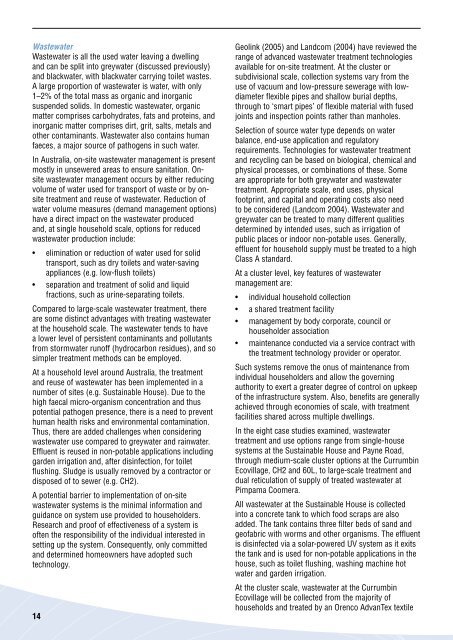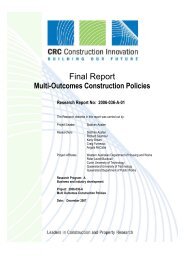Sustainable subdivisions - Construction Innovation
Sustainable subdivisions - Construction Innovation
Sustainable subdivisions - Construction Innovation
- No tags were found...
Create successful ePaper yourself
Turn your PDF publications into a flip-book with our unique Google optimized e-Paper software.
WastewaterWastewater is all the used water leaving a dwellingand can be split into greywater (discussed previously)and blackwater, with blackwater carrying toilet wastes.A large proportion of wastewater is water, with only1–2% of the total mass as organic and inorganicsuspended solids. In domestic wastewater, organicmatter comprises carbohydrates, fats and proteins, andinorganic matter comprises dirt, grit, salts, metals andother contaminants. Wastewater also contains humanfaeces, a major source of pathogens in such water.In Australia, on-site wastewater management is presentmostly in unsewered areas to ensure sanitation. Onsitewastewater management occurs by either reducingvolume of water used for transport of waste or by onsitetreatment and reuse of wastewater. Reduction ofwater volume measures (demand management options)have a direct impact on the wastewater producedand, at single household scale, options for reducedwastewater production include:• elimination or reduction of water used for solidtransport, such as dry toilets and water-savingappliances (e.g. low-fl ush toilets)• separation and treatment of solid and liquidfractions, such as urine-separating toilets.Compared to large-scale wastewater treatment, thereare some distinct advantages with treating wastewaterat the household scale. The wastewater tends to havea lower level of persistent contaminants and pollutantsfrom stormwater runoff (hydrocarbon residues), and sosimpler treatment methods can be employed.At a household level around Australia, the treatmentand reuse of wastewater has been implemented in anumber of sites (e.g. <strong>Sustainable</strong> House). Due to thehigh faecal micro-organism concentration and thuspotential pathogen presence, there is a need to preventhuman health risks and environmental contamination.Thus, there are added challenges when consideringwastewater use compared to greywater and rainwater.Effl uent is reused in non-potable applications includinggarden irrigation and, after disinfection, for toiletfl ushing. Sludge is usually removed by a contractor ordisposed of to sewer (e.g. CH2).A potential barrier to implementation of on-sitewastewater systems is the minimal information andguidance on system use provided to householders.Research and proof of effectiveness of a system isoften the responsibility of the individual interested insetting up the system. Consequently, only committedand determined homeowners have adopted suchtechnology.14Geolink (2005) and Landcom (2004) have reviewed therange of advanced wastewater treatment technologiesavailable for on-site treatment. At the cluster orsubdivisional scale, collection systems vary from theuse of vacuum and low-pressure sewerage with lowdiameterfl exible pipes and shallow burial depths,through to ‘smart pipes’ of fl exible material with fusedjoints and inspection points rather than manholes.Selection of source water type depends on waterbalance, end-use application and regulatoryrequirements. Technologies for wastewater treatmentand recycling can be based on biological, chemical andphysical processes, or combinations of these. Someare appropriate for both greywater and wastewatertreatment. Appropriate scale, end uses, physicalfootprint, and capital and operating costs also needto be considered (Landcom 2004). Wastewater andgreywater can be treated to many different qualitiesdetermined by intended uses, such as irrigation ofpublic places or indoor non-potable uses. Generally,effl uent for household supply must be treated to a highClass A standard.At a cluster level, key features of wastewatermanagement are:••••individual household collectiona shared treatment facilitymanagement by body corporate, council orhouseholder associationmaintenance conducted via a service contract withthe treatment technology provider or operator.Such systems remove the onus of maintenance fromindividual householders and allow the governingauthority to exert a greater degree of control on upkeepof the infrastructure system. Also, benefi ts are generallyachieved through economies of scale, with treatmentfacilities shared across multiple dwellings.In the eight case studies examined, wastewatertreatment and use options range from single-housesystems at the <strong>Sustainable</strong> House and Payne Road,through medium-scale cluster options at the CurrumbinEcovillage, CH2 and 60L, to large-scale treatment anddual reticulation of supply of treated wastewater atPimpama Coomera.All wastewater at the <strong>Sustainable</strong> House is collectedinto a concrete tank to which food scraps are alsoadded. The tank contains three fi lter beds of sand andgeofabric with worms and other organisms. The effl uentis disinfected via a solar-powered UV system as it exitsthe tank and is used for non-potable applications in thehouse, such as toilet fl ushing, washing machine hotwater and garden irrigation.At the cluster scale, wastewater at the CurrumbinEcovillage will be collected from the majority ofhouseholds and treated by an Orenco AdvanTex textile
















